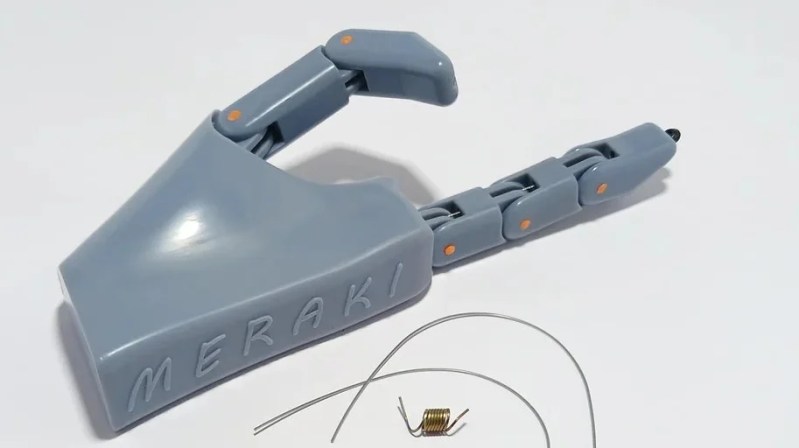Generally, when we’re looking to build something that moves we reach for motors, servos, or steppers — which ultimately are all just variations on the same concept. But there are other methods of locomotion available. As [Jamie Matthews] demonstrates, Nitinol wires can be another way to help get things moving.
Nitinol is a type of metal wire made of nickel and titanium that is also known as “memory wire”, because it can remember its former shape and transition back to it with a temperature change. [Jamie] uses this property to create a simple hand that is actuated by pieces of wire sourced from Amazon. This is actually a neat way to go, as it goes some way to mimicking how our own hands are moved by our tendons.
[Jamie] does a great job of explaining how to get started with Nitinol and how it works in a practical sense. We’ve seen it put to some wacky uses before, too, such as the basis for an airless tire.
















Question for a wizard: can this material (or similar) oscillate between two forms at high frequency (MHz+)?
Looking at the video i’d say no.
Yeah, I thought I had a real revolutionary idea back in the late 80s. Results were disappointing. Fractions of a Hz is where you want to be measuring this. I found bimetallic strips to be more easily sourced and cheaper. I think I still have the Nitinol wire in it’s original package somewhere, waiting for a more practical use.
There are piezoelectric stacks with levers attached that can move with a fair amount of speed and force, sometimes on the order of several millimetres. They can be a little pricey if ordered off the shelf. Building one is certainly on my todo list.
Can you elaborate on what “piezoelectric stacks with levers attached” actually means? Any links or more specific pointers?
Something like ultrasonic piezo transducer; with such devices it can be better to just look for something piezo that has a high displacement rating rather than try for common terminology. Not to say there isn’t a better term I can’t think of at the moment.
Nitinol is the most underrated actuator… but that probably because it requires a LOT of current. It seems like it’s suited for systems that only need to be used occasionally and if weight is a factor. It’s biggest problem though is that it’s insanely overpriced which I assume is due to patents, rare use, or something else I haven’t considered. I love the stuff but I could never afford to put it any of my projects.
I’ve often wondered about using some other heating and cooling method. Perhaps a pumped liquid or even wrapping them in a nichrome heating coil.
Perhaps they could be painted with black paint and used for self adjusting solar panels.
I wonder if they were twisted and used to move a heatsink with half painted black and half reflective, they could be made to oscillate in the sun, coating them with piezoelectric material, maybe they could generate electricity.
For the solar panel idea, you could probably just get by with some wax cylinders. Like a greenhouse vent actuator.
You can easily make heat engines with it:
https://www.youtube.com/watch?v=sscoMtJV0uY
I think its patents dried up long ago…
It’s one of those things that sound perfect on paper, but when you get to play with it, it turns out a disappointment.
Too many weird properties, like superelasticity, or creep under tension.
I played with this stuff years ago, still have a good bit laying around. Very cool stuff, but very difficult to use. You can’t solder to it, so there’s that. You apply power (as mentioned, lots sometimes, it works off of heat, so….) and it does it’s thing, contract. Then you need to mechanically pull it back into shape so you can do it again. And that sometimes requires a lot of pull. Too much, pull, or heat, and you blow it.
It’s really a solution, lpking for a problem.
I think somebody did make a heart or blood pump with it years ago, don’t know if it’s still around though.
(I did think of using two pieces so they oppose each other, one to contract and one to stretch it again (instead of say, a spring). But I never go around to trying it out.)